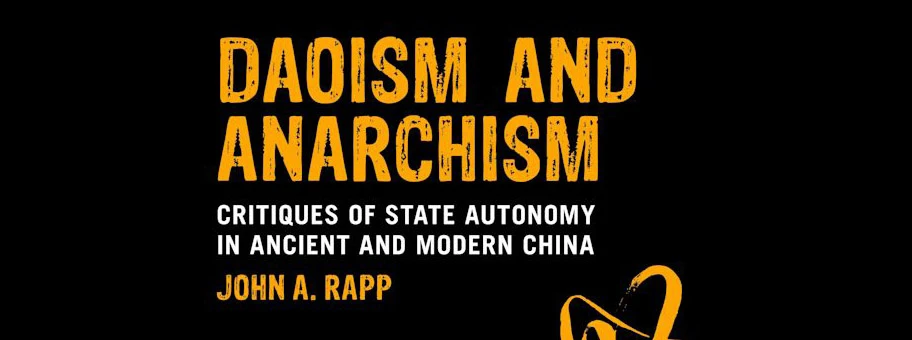John A. Rapp: Daoism and Anarchism Anarchist Studies Vol. 6
Sachliteratur
Der Politikwissenschaftler John A. Rapp verbindet in seinem Buch Daoism and Anarchism. Critiques of State Autonomy in Ancient and Modern China drei Felder.

Mehr Artikel
Buchcover.
2
1
«The basic anarchist thesis, this book argues, is not limited in time or by region. Anarchist thought can and has occurred many times and in many places in history and not just among those thinkers and activists in Europe from the early to mid-nineteenth century who consciously took on the anarchist label and who started a movement that then spread throughout the world, including to China, in the late nineteenth and early twentieth centuries. While the adherents of that movement were for the most part explicitly socialist or communist in orientation and favored revolutionary methods to implement their ideals, such ideas and commitments, however important and necessary they may have been, do not in themselves distinguish anarchists from other socialist revolutionaries. Instead, this book argues, it is their critique of states, whether capitalist or socialist, as, in the end, ruling for themselves that gave the anarchist movement its greatest power and coherence.» Rapp, John A., Daoism and Anarchism. Critiques of State Autonomy in Ancient and Modern China, London/New York 2012, S. 3f.
Der daoistische Begriff wujun („ohne einen Prinzen“) meint Rapp zufolge inhaltlich das gleiche, wie die griechische Formulierung an-archos („ohne Herrn“). Weiterhin verdeutlicht er, dass es auch im chinesischen Kontext von unterschiedlichen anarchistischen Strömungen gesprochen werden kann, die eher individualistisch oder kollektivistisch, eher „philosophisch“ oder politische engagiert sind. Dass daoistische Denken kann dabei in einer Opposition zum staatstragenden Konfuzianismus der Han-Dynastie gesehen werden. Der sogenannte „Legalismus“ ist eine politisch-theoretische Strömung, welche einen ähnlichen Charakter wie das Denken Niccolo Michiavellis für den europäischen Kontext einnimmt – und dementsprechend gegen den Anarchismus gerichtet. Eine glaubhafte Untersuchung – so macht Rapp deutlich – kann selbstverständlich der langen und vielfältigen Tradition des Daoismus nicht pauschal unterstellen „anarchistisch“ zu sein. Hier gilt es also genau hinzuschauen, Quellen zu studieren und zu interpretieren. Der Weg der Wei-Jin Daoisten wie Ruan Ji (210-263), Bao Jingyan (um 300), Tao Qian (326–397) schien weniger einem gewaltsamen Aufbegehren zu entsprechen, denn eher eine pazifische intellektuelle Dissidenz darzustellen, welche den Mythos des Staates und den Glauben an seine Legitimität eher von innen heraus untergrub. Gemeinsamkeiten ergeben sich weiterhin im nihilistischen und anti-utopischen Denken, der unter anderem Wu Nengzi im 9. Jh. mit einem buddhistischen Einfluss formulierte.
Eine anarchistische Strömung war in China zwischen den 1910er und 1950er Jahren aktiv und stand damit sowohl in Konflikt mit der alten Ordnung, wie mit der kommunistischen Partei unter Mao. Letzterer bediente daher ausgiebig Klischeevorstellungen gegenüber Anarchist*innen, um sie auszugrenzen. Die chinesischen Anarchist*innen des 20. Jh. adaptierten offenbar auch europäische Konzepte wie jenes der sozialen Revolution, verbanden diese aber mit ihren eigenen anti-staatlichen Traditionen. Ein bekannter Anführer der anarchistischen Bewegung war Shifu (zwischen 1911 und seinem Tod 1915 ) und Liu Shipei (zwischen 1907 und 1910 im Exil in Tokyo). Eine historische Wegmarke in diesem Zeitraum war die Etablierung der chinesischen Republik im Zuge der Revolution im Jahr 1912.
In den 1920er Jahren hatten Anarchist*innen den Marxismus-Leninismus vehement kritisiert, insbesondere wegen seines Konzeptes der Diktatur des Proletariats, wobei ihnen unter anderem auch die Schriften Bakunins und Kropotkins bekannt waren. Mao selbst war aufgrund der Stärke und Verbreitung anarchistischer Positionen ähnlich wie Lenin gezwungen, sich mit deren Argumenten auseinanderzusetzen und sie zumindest alibimässig in seine eigene Theorie zu integrieren. Im gefestigten „sozialistischen“ China wurde der Anarchismus jedoch zwischen 1957 und 1976 vehement denunziert und verdrängt. Doch selbst in jüngerer Zeit sei wieder eine neo-anarchistische Tendenz in China entstanden, argumentiert Rapp. Allerdings ist angesichts der Ausweitung der autokratischen Befugnisse des Staatspräsidenten und Generalsekretärs der KPCh Xi Jinping anzunehmen, dass diese auch weiterhin einen schweren Stand haben. Rapp fasst zusammen:
«The basic anarchist idea has broken through the surface at widely spaced geographic places and many different points in time throughout history, almost always to suffer severe repression, but the fact that anarchists of all kinds have been a small minority of all thinkers or that anarchist interpretations of traditions as different as Christianity, Marxism, or Daoism are all almost equally put down as heretical or blasphemous can never extinguish the anarchist impulse as long as states inevitably seek to augment their own power and autonomy at the expense of their subjects. What Daoist anarchism would teach anyone trying to revive a radical critique of state autonomy is that people must constantly be on guard for making compromises with the state out of their own interests as intellectuals and political activists. Radical Daoist thinkers at their best (as in Bao Jingyan) and at their most contradictory (as in Wu Nengzi) may teach other anarchists the crucial difference between everything and nothing: without an underlying positive vision of society as always able to thrive on its own without a state, though certainly without trying to turn that vision into detailed blueprints to be imposed on anyone else, any anarchist or neo-anarchist critique can too easily degenerate into nihilism and/or compromises with state authority. If necessarily based on such an underlying positive vision, however, it is the constant and consistent critique of state autonomy that must come first and foremost for any true anarchist.»
John A. Rapp: Daoism and Anarchism. Critiques of State Autonomy in Ancient and Modern China, London/New York 2012. 240 Seiten. ca. SFr. 36.00. ISBN: 9781441178800.


